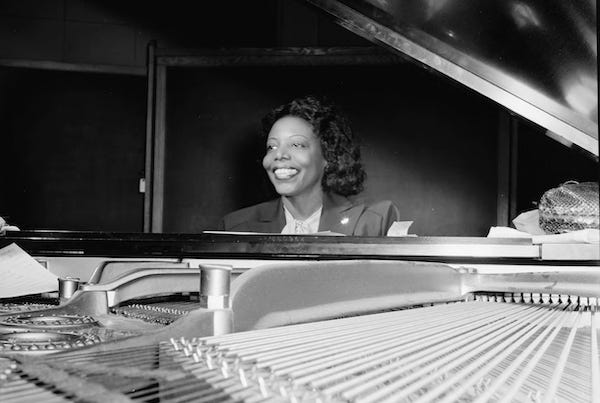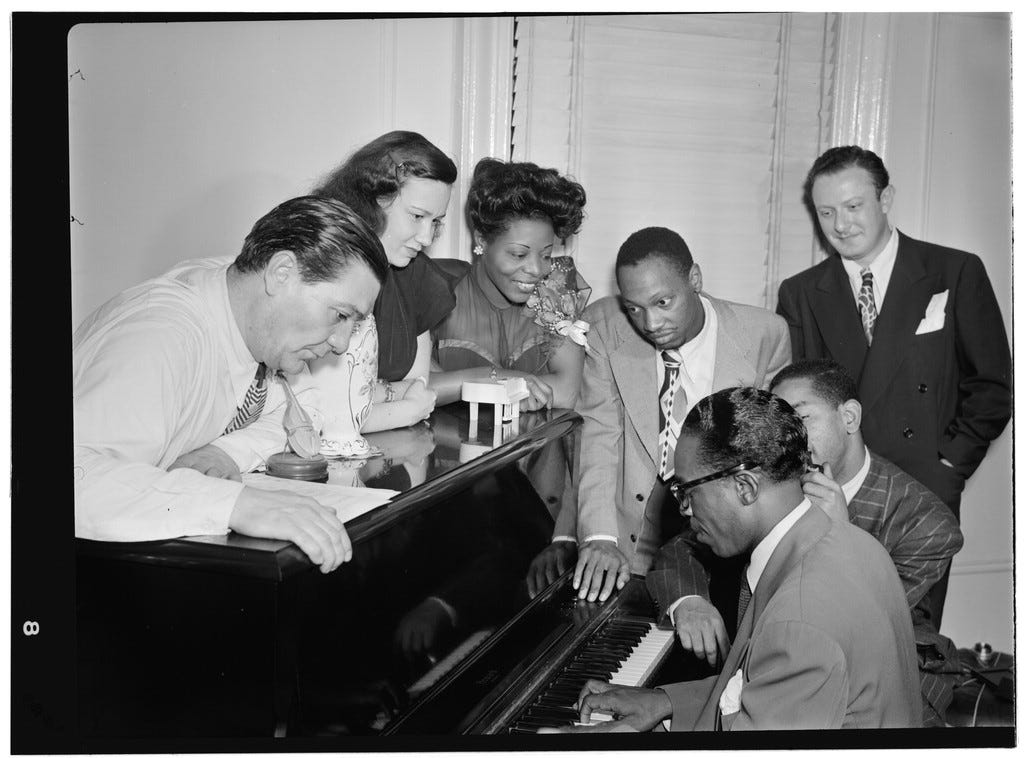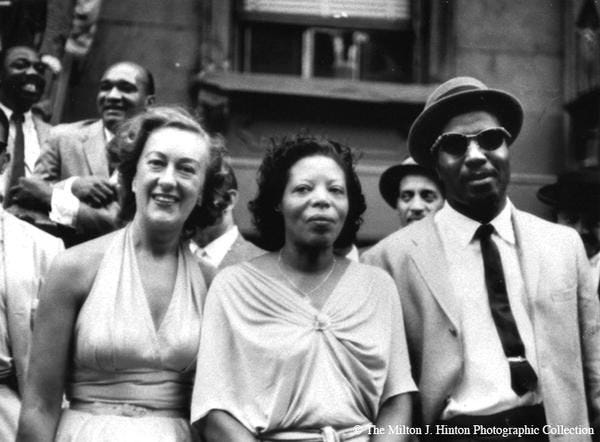This week, we are going to look and listen to a musician whose career spanned virtually the whole of jazz history, and what is more, it is a woman.
Mary Lou Williams is possibly one of the most underrated musicians in the history of jazz, yet as a pianist and arranger, she had more influence than many well-known jazz musicians. She wrote hundreds of compositions and arrangements and recorded more than one hundred records (in 78, 45, and LP versions). Williams wrote and arranged for Duke Ellington and Benny Goodman, and she was a friend, mentor, and teacher to Thelonious Monk, Charlie Parker, Miles Davis, Tadd Dameron, Bud Powell, and Dizzy Gillespie.
Williams was born in Atlanta, Georgia, the second of eleven children, and grew up in the East Liberty neighborhood of Pittsburgh, Pennsylvania. A musical prodigy, at the age of two, she was able to pick out simple tunes and by the age of three, she was taught piano by her mother.[Mary Lou Williams played piano out of necessity at a very young age. Her white neighbors were throwing bricks into her house as she annoyed them, until Williams began playing the piano, for them in their homes.
She began performing publicly at the age of seven when she became known admiringly in Pittsburgh as "The Little Piano Girl". She became a professional musician at the age of 15, citing Lovie Austin as her greatest influence. During a trip to Chicago, she recorded "Drag 'Em" and "Night Life" as piano solos. She used the name "Mary Lou" at the suggestion of Jack Kapp at Brunswick Records. The records sold briskly, raising Williams to national prominence.
By 1925, Mary was working as a full-time musician, just 15, She married 20-year-old jazz saxophonist John Overton Williams in the November of 1926. She met him at a performance in Cleveland where he was leading his group, the Syncopators. Mary moved with John to Memphis, Tennessee, where he assembled a band… with his wife on the piano. What a time for her. playing jazz in Memphis and still, just 16.
Here is a recording of the band playing “The Bumps”
Her arranging career began in 1929 when her husband joined Andy Kirk’s band: The Twelve Clouds of Joy. A missing pianist left a spot open for Mary and she seized the opportunity to prove her worth. Eager to impress, she presented a wide array of new compositions. Not yet confident enough to write down her arrangement, her understanding of arranging still in its infancy, Mary dictated her ideas to Kirk. Eventually, she accepted a long-standing engagement in Kansas City, Missouri, sitting in with the band as well as serving as its arranger and composer. She provided Kirk with hits such as ‘Froggy Bottom’.These were the days of the Depression, with few opportunities for the band to play and fewer still to record. Mary spent almost all of her time refining her skills, spending much time in ‘jam sessions’. A falling out with her husband over money took a toll on their marriage. Mary no longer wanted to share a bed with John, instead preferring to stay up all night writing.
Whilst ‘Froggy Bottom’ was recorded in 1929, it was not widely released until 1936 and it was Mary’s first memorable composition and arrangement. Variety dubbed it, ‘Real, dirty jazz’. Whatever that means. The song was recorded with Twelve Clouds of Joy, meeting her label’s demand for ‘something sweet’. Mary was less than pleased with the glossy and saccharine nature of the piece,
The record, romantic yet not overbearing, sold briskly, a boon for Mary and her career, raising her to national prominence.
Benny Goodman asked her to write a blues song for his band. The result was"Roll 'Em", a boogie-boogie piece based on the blues, which followed her successful "Camel Hop", named for Goodman's radio show sponsor, Camel cigarettes. Goodman tried to put Williams under contract to write for him exclusively, but she refused, preferring to freelance instead.
In 1942, Williams, who had divorced her husband, left the Twelve Clouds of Joy returning again to Pittsburgh. She was joined there by bandmate Harold "Shorty" Baker, with whom she formed a six-piece ensemble that included Art Blakey on drums. Here is the band playing “Harmony Blues”
After an engagement in Cleveland, Baker left to join Duke Ellington's orchestra. Williams joined the band in New York City, then traveled to Baltimore, where she and Baker were married. She traveled with Ellington and arranged several tunes for him, including "Trumpet No End" (1946), her version of "Blue Skies" by Irving Berlin.
The trumpeters are Taft Jordan, Harold Baker, Ray Nance, Francis Williams, and Cat Anderson.
Williams accepted a job at the Café Society Downtown, started a weekly radio show called Mary Lou Williams's Piano Workshop on WNEW, and began mentoring and collaborating with younger bebop musicians such as Dizzy Gillespie and Thelonious Monk."During this period Monk and the kids would come to my apartment every morning around four or pick me up at the Café after I'd finished my last show, and we'd play and swap ideas until noon or later", Williams recalled in Melody Maker.
Williams in her apartment with Jack Teagarden, Tadd Dameron, Hank Jones and Dizzy Gillespie
Marian McPartland, Mary Lou Williams and Thelonius Monk.
This was her first recording when she moved into playing bop, made in 1945. The tracks were recorded for the Continental label in 1945 with guitarist Mary Osborne, bassist Bea Taylor, and percussionists Margie Hyams and Bridget O'Flynn, a fascinating duo who took turns either handling the vibraphone or the drums. This little group sounds perfectly up to date, pleasantly newfangled on "Rumba Rebop," a reference to that new style that in 1945 was already becoming known instead as bebop.
.In 1945, she composed the bebop hit "In the Land of Oo-Bla-Dee" for Gillespie. Mary Lou Williams co-wrote this novelty song with her arranging and composition teacher Milton Orent. She arranged this for Dizzy Gillespie's band in 1949 and it was recorded with vocalist Joe Carroll. It was written to also feature Dizzy.
Here is a piece featuring an all-women group. by Mary Lou showing how her piano playing was influenced by the bop movement. Mary Lou Williams (piano) Mary Osborne (guitar) Margie Hyams (vibraharp) June M. Rotenberg (bass) Rose Gottesman (drums) playing “Conversation”
In 1945, she composed the classical-influenced Zodiac Suite, in which each of the twelve parts corresponded to a sign of the zodiac, and were accordingly dedicated to several of her musical colleagues, including Billie Holiday, and Art Tatum. She recorded the suite with Jack Parker and Al Lucas With just a casual interest in astrology, Mary Lou Williams created her 1945 Zodiac Suite as a series of character sketches, and musical portraits of friends from each sign that she would debut on a weekly radio show. "Aries" is for Ben Webster and Billie Holiday, "Taurus" for Duke Ellington, and "Libra" for Dizzy Gillespie, Art Tatum, Bud Powell and Thelonious Monk. The pieces include piano solos, duets with bassist Al Lucas, and trios with the addition of drummer Jack "The Bear" Parker. The suite is both a remarkable exercise in extended composition and an index of Williams' varied palette. Her mix of blues and boogie roots and strikingly modernist harmonies is sometimes similar to Monk's, while her lighter, impressionist playing can evoke Claude Debussy (and the way Debussy coloured the piano music of Bix Beiderbecke). The cumulative work, though, has a warmly sustained lyricism that can only suggest comparisons with Ellington. The Zodiac Suite would assume more ambitious forms, with a chamber orchestra setting for the entire suite later in 1945 and a large orchestra adaptation of three movements a year later. Dizzy Gillespie recorded three movements with his big band in 1957. But the intimacy of these original recordings is very special, with Williams effectively blurring the line between composition and improvisation. Here are “Aries” and “Libra”
Despite the high regard in which she was held by younger musicians, Williams had a hard professional time of it in the late 1940s and early 50s, In 1952, Mary accepted an offer to perform in England, ending up staying in Europe for two years. But by this point, music had engulfed her life. She was mentally and physically drained. It led to her hiatus. Some think it was triggered by the death of Charlie Parker, one of her oldest friends. Mary was burnt out. She was taken advantage of and abused by her husbands, managers, and club owners. During a performance in Paris in 1954, she walked off stage, not playing music again until 1957.
While she was in Europe in the mid-1950s Williams experienced a personal crisis that led her to take a strong religious turn in her life. For several years she did not perform, and after returning to America devoted her energy instead to running a thrift shop and helping out drug-addicted musicians.
When Williams did begin to re-emerge as a jazz artist, some of her new original material was cast in the mode of what would come to be known as "sacred jazz"—jazz performed in a church setting as part of a modernized church service. In this she was several years ahead of Duke Ellington, who would write and perform three sacred jazz concerts in the final years of his life. She also released the recordings on her own label, Mary Records, which puts her in the lineage of jazz history's "do-it-yourself" artists.
Medi1 and Medi 2 are part of an album called Zoning, which covered parts of the Mass she wrote in the 1960s. Mary Lou Williams's magnum opus of religious jazz: Mary Lou's Mass. Newsweek called the score "an encyclopedia of black music, richly represented from spirituals to bop to rock." This is Williams's "Music for Peace," a landmark recording that addressed many of the social ills of the 1960s and 70s. It is perhaps the most openly religious jazz recording made at that time. In her own words, it is "Music for the Soul."
In the early 1970s, Williams became a fixture on the live New York City jazz scene again, performing regularly at the Cookery, a restaurant operated by former Café Society owner Barney Josephson. In the late 1970s, she became a jazz educator in residence at Duke University,
While she was there, she made this recording featuring two trumpet players from opposite ends of the music scene: Bobby Hacket and Dizzy Gillespie.
She also played a legendary duets concert with avant-garde pianist Cecil Taylor, which received mixed reviews and was released under the title Embraced, though one writer waggishly suggested that it should be called Clashed.
Embraced Review by Scott Yanow “This encounter is a disaster. Mary Lou Williams, who always prided herself on being open-minded, arranged to perform a duo piano concert with the avant-garde master Cecil Taylor. She wanted them to go through her usual history-of-jazz program but neglected to gain Taylor's consent and, since he never compromises his atonal music, the lack of communication between the two players is laughable. While Williams tries to demonstrate blues, ragtime, stride, and swing, Taylor plays in his usual dense and dissonant style on top of her. The result is a complete mess that is almost impossible to listen to.”
A few months later Williams went to the opposite end of the musical spectrum and played with Benny Goodman at Carnegie Hall, leading her to declare, "Now I can really say I played all of it." She'd echo a similar sentiment not long after that on Marian McPartland's Piano Jazz program, saying "I'm the only living musician that has played all the eras."
She released numerous albums throughout the 1970s, including a few as a solo pianist. She could also be seen playing nightly in Greenwich Village at The Cookery, a new club. Her final recording, Solo Recital (1978), had a medley encompassing spirituals, ragtime, blues, and swing.
She was at the top of her game in the final years. But just three years later, Mary Lou Williams died of bladder cancer in Durham, North Carolina, at the age of 71.
Andy Kirk, Benny Goodman, and Dizzy Gillespie attended her funeral. Gone was one of the most successful female jazz stars the world had ever known, her outstanding musical legacy there for all to see. She left behind the Mary Lou Williams Foundation to advance the public knowledge of jazz. The First Lady of the Jazz Keyboard had died.
R.I.P. Mary Lou Williams







Wow, you are fast and furious in your posting. Another fascinating read.